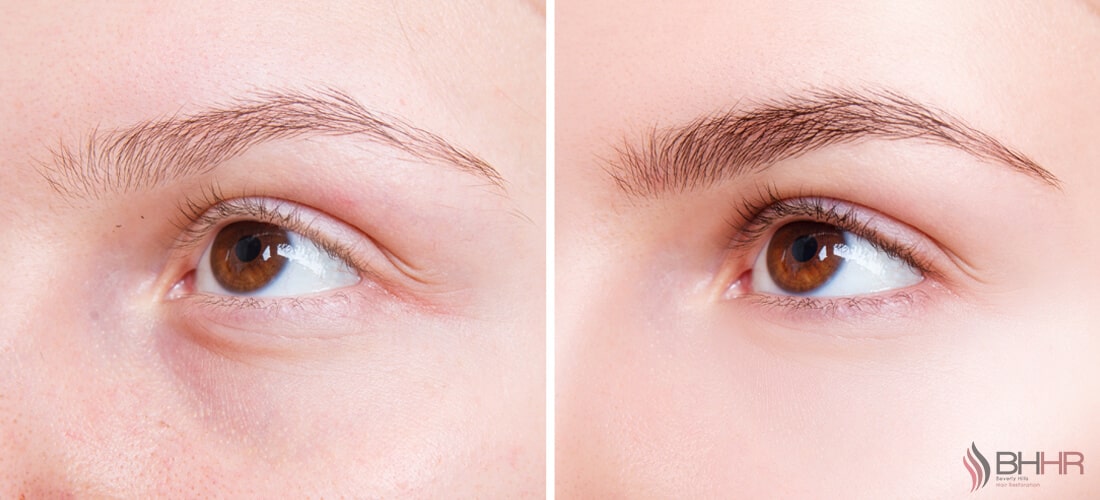What is Eyebrow Transplant: The Ultimate Guide
Home / Eyebrow Hair Transplant / What is Eyebrow Transplant: The Ultimate Guide
Updated On : July 18, 2024 | Category : Eyebrow Hair Transplant | Author: Beverly Hills Hair Restoration Team

An eyebrow transplant is a process that involves the transfer of hairs from one part of the body, typically the scalp, to the eyebrow area to enhance or restore the appearance of the eyebrows. This treatment has gained popularity recently as more individuals seek ways to improve their facial aesthetics and boost their self-confidence. Eyebrows play an essential role in facial symmetry and expression, framing the eyes and contributing significantly to one's overall facial appearance. Thinning or sparse eyebrows can be a source of concern for many, impacting self-esteem and how others perceive them.
At Beverly Hills Hair Restoration Clinic in Los Angeles, Dr. John Kahen understands the importance of eyebrows in defining facial features. We aim to provide a comprehensive solution that addresses hair transplant concerns and ensures natural-looking and long-lasting results. An eyebrow transplant can be a life-changing procedure for those looking to enhance their facial harmony and regain confidence in their appearance.
What is Eyebrow Transplant?
An eyebrow transplant is a surgical treatment developed to reform or improve the appearance of the eyebrows. Dr. Kahen at Beverly Hills Hair Restoration Clinic in Los Angeles specializes in this procedure, which involves transferring hair follicles from the patient’s donor area, naturally the back of the scalp, to the eyebrow region. An eyebrow transplant aims to create fuller, more defined eyebrows, catering to individuals who have experienced hair loss due to over-plucking, genetics, medical conditions, or aging.
There are primarily two types of eyebrow transplant procedures: Follicular Unit Transplantation (FUT) and Follicular Unit Extraction (FUE). FUT concerns taking a strip of skin with hairs from the donor area, while FUE involves extracting individual hair follicles. Both methods aim to achieve natural-looking results, enhancing facial symmetry and expression. The procedure selection depends on the patient's specific requirements and the expertise of the hair transplant clinic.
Who Can Benefit from Eyebrow Transplant
- Scarring: An eyebrow transplant can address hair loss caused by scarring from accidents, burns, or surgeries.
- Over-plucking: Excessive grooming practices like plucking or threading can damage hair follicles, leading to sparse growth that may benefit from transplantation.
- Genetic factors: Some individuals inherit thin or sparse eyebrows, making them suitable candidates for eyebrow transplant to enhance their appearance.
- Medical conditions: Conditions such as alopecia areata, thyroid disorders, or trichotillomania can result in eyebrow hair loss, which can be addressed through transplant procedures.
- Aging: As people age, hormonal changes or reduced blood circulation can cause thinning or loss of eyebrow hair, making transplant an option for restoring fullness.
- Psychological impact: Restoring or enhancing eyebrows through transplant can boost self-esteem and confidence, positively impacting overall well-being.
Eyebrow Transplant Procedure Overview
- Free Consultation: Free hair transplant consultation with Dr. John Kahen at Beverly Hills Hair Restoration Clinic to assess your needs and discuss expectations.
- Pre-Procedure Planning: Designing the desired eyebrow shape and determining the required graft number.
- Donor Area Selection: Choosing a suitable donor area, usually from the scalp, where hair closely matches eyebrow hair.
- Local Anesthesia: Administering anesthesia to the donor and recipient areas for a comfortable experience.
- Follicle Extraction: Extract individual hair follicles from the donor area using a precise extraction tool.
- Recipient Area Preparation: Tiny incisions in the eyebrow area are made to receive the transplanted follicles.
- Follicle Placement: Carefully insert the hair follicles into the prepared incisions, following the natural growth direction.
- Post-Procedure Care: Providing instructions for caring for the transplanted area to ensure optimal healing and growth.
Eyebrow Transplant Benefits
Eyebrow transplant offers numerous benefits, including enhanced facial aesthetics, restored confidence, and a youthful appearance. With expert care from Beverly Hills Hair Restoration Clinic, you can achieve these benefits that transform your look:
- Permanent Solution
- Boost in Confidence
- Natural-Looking Results
- Minimal Maintenance
- Customizable
- Safe and Effective
- Enhanced Facial Expression
The Transformative Potential of Eyebrow Transplant: A Conclusion
An eyebrow transplant is a specialized hair restoration procedure designed to enhance the eyebrows' density, shape, and overall appearance. This technique involves transferring hair follicles from a donor area to the eyebrow region, offering a permanent solution for those seeking to improve their facial aesthetics. Our hair transplant doctor at Beverly Hills Hair Restoration Clinic in Los Angeles is committed to providing the highest standard of care and performing natural-looking results. We understand the impact of well-defined eyebrows on confidence and facial harmony. If you are considering an eyebrow transplant, we encourage you to take the first step towards transforming your look. Dr. Kahen offers free hair transplant consultation to assess your needs and guide you through the process. With the right expertise and care, he can enhance your appearance by allowing you to enjoy the beauty and confidence of perfectly shaped and full eyebrows.
Discover your transformative eyebrow hair restoration journey options with a free hair transplant consultation at Beverly Hills Hair Restoration. Call us today at 310.289.0901 to schedule your appointment and take the first step towards fuller, more vibrant eyebrows.
